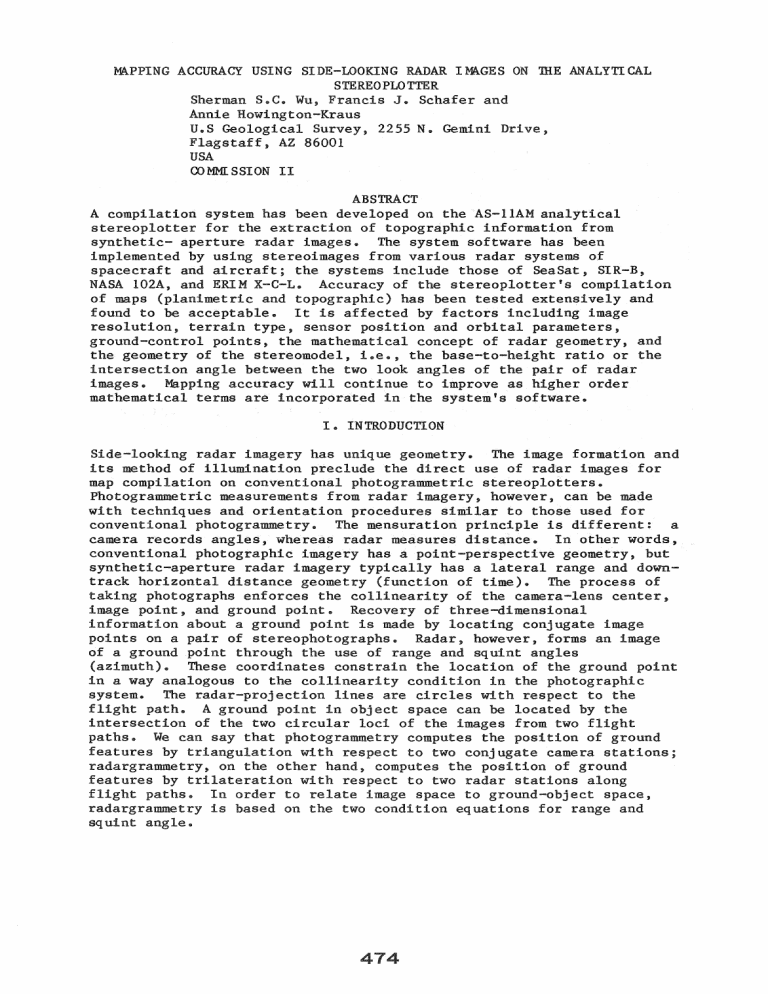MAPPING ACCURACY USING SIDE-LOOKING RADAR I... STEREOPLOTTER Sherman S.C. Wu, Francis J. Schafer...

MAPPING ACCURACY USING SIDE-LOOKING RADAR I MAGES ON TIlE ANALYTI CAL
STEREOPLOTTER
Sherman S.C. Wu, Francis J. Schafer and
Annie Howington-Kraus
U.S Geological Survey, 2255 N. Gemini Drive,
Flagstaff, AZ 86001
USA
COMMI. SSION II
ABSTRACT
A compilation system has been developed on the AS-11AM analytical stereoplotter for the extraction of topographic information from synthetic- aperture radar images. The system software has been implemented by using stereoimages from various radar systems of spacecraft and aircraft; the systems include those of Sea Sat , SIR-B,
NASA 102A, and ERIM X-C-L. Accuracy of the stereoplotter's compilation of maps (planimetric and topographic) has been tested extensively and found to be acceptable. It is affected by factors including image resolution, terrain type, sensor position and orbital parameters, ground-control points, the mathematical concept of radar geometry, and the geometry of the stereomodel, i.e., the base-to-height ratio or the intersection angle between the two look angles of the pair of radar images. Mapping accuracy will continue to improve as higher order mathematical terms are incorporated in the system's software.
I.. INTRODUCTION
Side-looking radar imagery has unique geometry. The image formation and its method of illumination preclude the direct use of radar images for map compilation on conventional photogrammetric stereoplotters.
Photogrammetric measurements from radar imagery, however, can be made with techniques and orientation procedures similar to those used for conventional photogrammetry. The mensuration principle is different: a camera records angles, whereas radar measures distance. In other words, conventional photographic imagery has a point-perspective geometry, but synthetic-aperture radar imagery typically has a lateral range and downtrack horizontal distance geometry (function of time). The process of taking photographs enforces the collinearity of the camera-lens center, image point, and ground point. Recovery of three-dimensional information about a ground point is made by locating conjugate image points on a pair of stereophotographs. Radar, however, forms an image of a ground point through the use of range and squint angles
(azimuth). These coordinates constrain the location of the ground point in a way analogous to the collinearity condition in the photographic system. The radar-projection lines are circles with respect to the flight path. A ground point in object space can be located by the intersection of the two circular loci of the images from two flight paths. We can say that photogrammetry computes the position of ground features by triangulation with respect to two conjugate camera stations; radargrammetry, on the other hand, computes the position of ground features by trilateration with to two radar stations along flight paths. In order to relate image space to ground-object space, radargrammetry is based on the two condition equations for range and squint angle ..
II. SOFTWARE
The development of a real-time mathematical model for stereoradar images was initiated by the Defense Mapping Agency by contracting to Autometric
Inc. (Blackwall, 1981). Based on results of this model and on range and squint condition equations and the associated geometric theory, compilation software for stereoradar imagery has been developed on the
AS-11AM analytical stereoplotter (Figure 1). This work has been done at the offices of the U.S. Geological Survey in Flagstaff, Arizona, and is a joint effort with the Defense Mapping Agency.
Figure 1. The AS-IIAM analytical stereoplotter, consisting of AS-II viewer interfaced to Modcomp 11-25 computer (64 K words of memory) with two cartridge disks, one large moving head disk (200 MB), two magnetic tape drives, one card reader, and one terminal.
If D is the distance from the instantaneous antenna position to the directly measured ground point, and D' is the same distance obtained from biscopic image measurements, then F = D' - D = 0 is the range condition equation that enforces the condition that values for the slant range from an instantaneous spacecraft position to the ground point are identical, whether they are derived from image measurements or from the displacement vector between the spacecraft and the ground point. If ~ is the angle between the spacecraft velocity vector to the ground point
(nominally 90°), and ~t is the squint angle derived from the Doppler equation with the component of radar-image coordinates, then G
- cos ~
= cos ~'
= 0 is the squint (azimuth) condition equation that enforces the condition that values for the angle between instantaneous spacecraft velocity vector and the image ray are identical, whether they are radargrammetrically inferred or derived from the Doppler equation
(Jackson, 1985). The reduction of the condition equations involves parameters that include the position of the vehicle (spacecraft or aircraft), velocity vector and acceleration, range and time factors, and
Doppler rate of change.
The synthetic aperture radar (SAR) compilation system is capable of performing interior orientation, measurement of control points, exterior orientation, data collection, and contouring. The system consists of an extensive software library and handles both slant- and ground-range geometry taken from either the same side or the opposite sides.
Setting up a stereomodel from SAR images for interior and exterior . orientations requires initial data that include Doppler frequency of radar images and time rate of change in Doppler frequency, time scaler and time bias (for time coordinate), range scaler and range bias (for range coordinate), X, Y, Z components of the position, velocity, and acceleration of the radar station along the flight path, and coordinates of as many as 30 control points. Standard deviations of these initial data must be entered so that all parameters can be refined through a least-squares adjustment, by iterations. To establish interior orientation, 4 to 16 measurable image points are entered with their time and range information. A real-time reseau program makes corrections for image points according to the calibrated data (range, time) of reseau points.
III. TESTING AND IMPLEMENTATION
Stereoimages from spacecraft (SeaSat and SIR-B) radar and from aircraft radar have been used to test the accuracy of the AS-I1AM analytical stereoplotter's compilation of both planimetric and contour maps (Table
1).
TABLE 1. RADAR I~GES USED FOR TESTING 'mE SAR (x)MPlLATION SYSTEM
Vehicle
Mission/Radar
System
SeaSat
Spacecraft
SIR-B NASA l02A
Aircraft
ERIM X-C-L
Site
Geometry*
I New Orleans Los Angeles Mt. Shasta Mt. St. Helens Spitsbergen
SS os
SS os
SS SS
Range** sa SR GR GR GR
*
SS--Same-side mode; OS--Opposite-side mode
**
SR--Slant-range geometry; GR--Ground-range geometry
SR & GR
SeaSat used an L-band radar with a 23.5-cm wavelength. The flight altitude was 800 km and the look angle was 20°. Its images have a resolution of 25 m. The New Orleans model was used to compile a planimetric map to test the SAR compilation system. The model covering the Los Angeles area was used to implement the compilation software; from it, a contour map was compiled at a scale of 1:250,000 and a contour interval of 10 m.
The SIR-B experiment used an L-band radar with a 23.0-cm wavelength and provided images at look angles of 15° to 60°. Therefore, resolution of the images ranges from 58 m to 17 m, depending on the look angle. The stereomodel from which the map of Mt. Shasta was compiled (Figure 2) used a pair of SIR-B images with look angles of 29.5° and 60.1°. Their resolutions are 28.5 m and 16.2 m, respectively.
Each of the two models of stereoradar images taken by the NASA 102A system was used to compile a contour map. However, the geometry of the
476
Figure 2. Contour map of Mt. Shasta. Compilation scale 1:200,000.
Contour interval 100 m; 50-m intermediate contours in northern part.
477
model having an opposite-side mode is stronger than the one having a same-side mode.
The two models taken by the ERIM X-C-L cover the same ground features but in different geometries (which are compatible). The model in ground-range geometry was used to compile a contour map (Figure 3).
IV. ~PPING ACCURACY
Mapping accuracy is affected by factors that include image resolution, terrain type, sensor position and orbital parameters, ground-control points, the mathematical concept of radar geometry, and the geometry of the stereomodel, i.e., the base-to-height ratio or the intersection angle between the two look angles of the pair of radar images. For example, average elevation-measurement residuals from three SIR-B stereomodels are 7.3 m, 8.3 m, and 33.9 m. Their respective intersection angles are 30.6°, 24.0°, and 6.6°.
The New Orleans model (Table 1) has a strong geometry with a base-toheight ratio of 0.97. Repeatability of elevation measurements from this model is 0.9 m with average elevation-measurement residuals of 18 m.
The Los Angeles model includes mountainous areas of high relief.
Extensive shadows appear in the pair of images, which prevent stereoviewing of the mountains. The model geometry is strong with a base-to-height ratio of 0.85 so that a repeatability of elevation measurements of ± 1.2 m was obtained. The average elevation measurement residual is ± 19.1 m.
The SIR-B model has a base-to-height ratio of 1.16. The repeatability of elevation measurement is 8 m with elevation-measurement residuals of
55.4 m.
Because the images obtained by the NASA 102A system are severely distorted, no evalution of accuracy was made.
The improvement of mapping precision of the analytical stereoplotters will require an enhancement of the SAR compilation software. We currently have a real-time reseau program for coordinate correction. We are now using higher order mathematical terms in the system software.
For example, the X, Y, Z components of the radar position along the flight path are functions of time. We can carry higher orders of time in each of the three polynomials, which will also enable us to carry higher orders for the three components of the velocity of the radar station along the flight path, the first derivative of the position polynomials.
This enhancement was tested with the stereomode1 of Spitsbergen (see
Figure 3). Results are shown in Table 2; standard errors of measurement of control points are 61.5 m and 18.2 m, respectively. Coordinates of control points were determined by the Defense Mapping Agency, using geodetic methods.
Figure 3. Contour map of vicinity of Longyearbyen, near Spitsbergen,
Norway. Compilation scale 1:25,000. Contour interval 20 m.
479
Table 2. SAR ELEVATION MEASUREMENTS BEFORE AND AFTER SOFTWARE ENHANCEMENT
Before Enhancement
Point Elevation ~asurement Error
After Enhancement
~asurement Error
ID (m) (m) (m) (m) (m)
----------------------------------------------------------------------
10
11
175
155
242
185
-67
-30
193
190
-18
-35
15 177 190 -13 178 -1
16 148 161 -13 165 -17
18 131 98 33 131 0
19
22
31
109
III
174
49
50
50
60
61
12
92
92
175
19
19
-1
Absolute ~an 50.1 13.5
V. CONCLUSIONS
After much testing and implementation, stereomodeling from radar images has proved feasible. Thus, the mathematical concept of the compilation system software is correct. All stereomodels tested were generally free of parallax and provided suitable bases for map compilation. The mapping accuracy, as well as the mathematical concept, will be improved by incorporating higher order mathematical terms in the software.
REFERENCES
Blackwall, B.H., 1981, Real-time math model for SAR imagery; Final
Tech. Report: Romer Air Development Center Tech. Report 301, 70 p.
Jackson, Michael, 1985, SAR compilation; Final Tech. Report: Romer Air
Development Center Tech. Report 85-82, 57 p.
Wu, S.S.C., Schafer, F.J., and Howington, Annie-Elpis, 1987, A compilation system for Venus Radar Mission (Magellan): Reports of the Planetary Geology and Geophysics Program-1986: NASA Tech. ~mo.
89810, p. 233-235.
480








